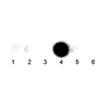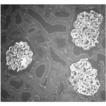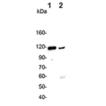Product Details
| Host: | Rabbit |
| |
| Immunogen: | Synthetic peptide corresponding to aa 28-38 (M28GDYMAQEDDW38) of human and rat actinin-4 and to aa 29-39 of mouse actinin-4. |
| |
| UniProt ID: | O43707 (human) |
| |
| Species reactivity: | Human, Mouse, Rat
Chinese hamster, Porcine
|
| |
| Crossreactivity: | Does not cross-react with actinin-1, -2 or -3. |
| |
| Applications: | IHC (FS), IHC (PS), IP, WB
|
| |
| Recommended Dilutions/Conditions: | Immunohistochemistry (frozen sections, 1µg/ml)
Immunoprecipitation (25µg/ml)
Western Blot (0.1-0.25µg/ml). The recommended dilutions refer to the analysis of mouse cells and tissues with intermediate levels of actinin-4 expression and must be viewed as approximate
Suggested dilutions/conditions may not be available for all applications.
Optimal conditions must be determined individually for each application. |
| |
| Purity Detail: | Epitope-affinity purified. |
| |
| Formulation: | Liquid. In PBS containing 1mg/ml BSA and 0.01% sodium azide. |
| |
| Handling: | Avoid freeze/thaw cycles. |
| |
| Shipping: | Blue Ice |
| |
| Short Term Storage: | +4°C |
| |
| Long Term Storage: | -20°C |
| |
| Scientific Background: | α-Actinin-4 is an actin-bundling protein of ~100kDa that is associated with cell motility, endocytosis, and cancer invasion. The α-actinin family comprises two non-muscle isoforms (α-actinin-1 and -4) and two skeletal muscle isoforms (α-actinin-2 and -3), with α-actinin-2 being also expressed in cardiac muscle. While α-actinin-4 is almost ubiquitously expressed, particularly high concentrations are found in glomeruli. On the subcellular level it is associated with actin stress fibers, but in certain cells it also localizes to the nucleus. Mutations in the α-actinin-4 gene cause an autosomal-dominant form of familial focal segmental glomerulosclerosis (FSGS), which is thought to result from a defect in glomerular podocyte function. A point mutation in the α-actinin-4 gene was found to generate an antigenic peptide that is recognized by autologous cytolytic T lymphocytes (CTL) on a human lung carcinoma. α-actinin-4 interacts with a variety of proteins, including the ring finger protein BERP, the PDZ-LIM protein CLP-36, the hemidesmosomal and cell-cell contact protein BP180, and the tight junction protein MAGI-1. Moreover, α-actinin-4 forms a ternary complex with Ca2+/ Calmodulin-dependent protein kinase II and Densin-180, a protein of postsynaptic densities in CNS neurons. Ca2+-dependent association of α-actinin-4 with E3KARP is required for Ca2+-dependent inhibition of the Na+/ H+exchanger 3 (NHE3). |
| |
| Regulatory Status: | RUO - Research Use Only |
| |
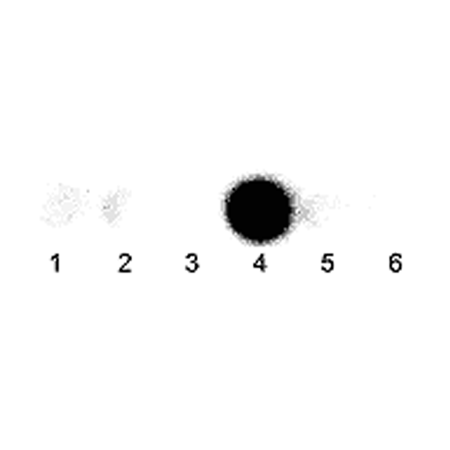
Isoform and species cross-reactivity in immunoblots determined with solid phase bound synthetic peptides.Spot 1: QTNDYMQPEEDWD - Actinin-1 (human, mouse, rat, chicken)Spot 2: DEDEYMIQEEEWD - Actinin-2 (human, mouse)Spot 3: GGGEYMEQEEDWD - Actinin-3 (human, mouse, rat)Spot 4: SMGDYMAQEDDWD - Actinin-4 (human, mouse, rat)Spot 5: GMGDYMRPGGDWD- Actinin-4 variant (rat)Spot 6: MDAWYSDEQMDGD - Control scrambled Actinin-4 peptide
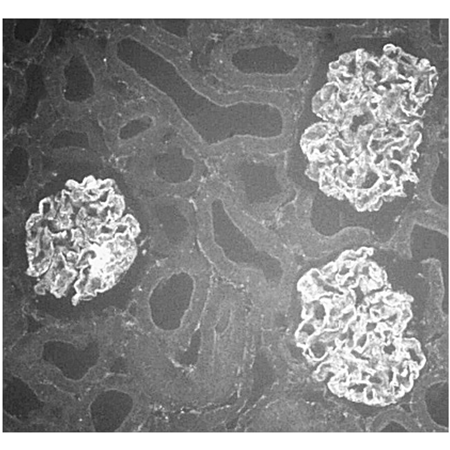
Immunohistochemistry of actinin-4 distribution in rat kidney using PAb to α-Actinin-4 (Prod. No. ALX-210-356).
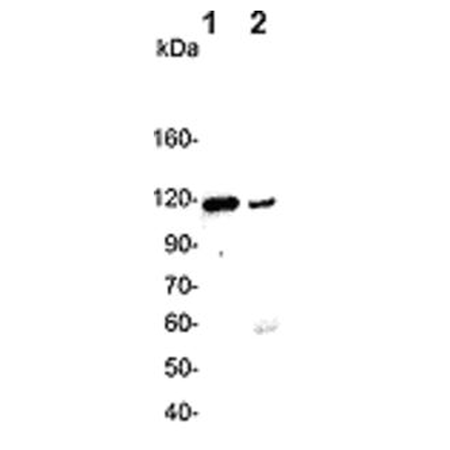
Western blot of mouse kidney (lane 1) and brain (lane 2) using PAb to α-Actinin-4 (Prod. No. ALX-210-356).
Please mouse over
Product Literature References
Expansion and Contraction of the Umbrella Cell Apical Junctional Ring in Response to Bladder Filling and Voiding: A.F. Eaton, et al.; Mol. Biol. Cell
2019, mbcE19020115 (2019),
Abstract;
NHERF1 inhibits beta-catenin-mediated proliferation of cervical cancer cells through suppression of alpha-actinin-4 expression: Q. Wang, et al.; Cell Death Dis.
9, 668 (2018),
Abstract;
Full Text
A complex of Rab13 with MICAL-L2 and α-actinin-4 is essential for insulin-dependent GLUT4 exocytosis: Y. Sun, et al.; Mol. Biol. Cell.
27, 75 (2016),
Application(s): Immunoblotting on PDVF membrane,
Abstract;
Full Text
The C-terminal domain controls the mobility of Crumbs 3 isoforms: I. Djuric, et al.; Biochim. Biophys. Acta
1863, 1208 (2016),
Application(s): Western blot,
Abstract;
Actinin-4 Governs Dendritic Spine Dynamics and Promotes their Remodeling by Metabotropic Glutamate Receptors: M. Kalinowska, et al.; J. Biol. Chem.
290, 15909 (2015),
Application(s): Confocal Microscopy, Western Blot,
Abstract;
Full Text
α-Actinin-4 Enhances Colorectal Cancer Cell Invasion by Suppressing Focal Adhesion Maturation: M. Fukumoto, et al.; PLoS One
10, e0120616 (2015),
Application(s): Western Blot,
Abstract;
Full Text
CART: an Hrs/actinin-4/BERP/myosin V protein complex required for efficient receptor recycling: Q. Yan, et al.; Mol. Biol. Cell
16, 2470 (2005),
Abstract;
Full Text
Podocyte involvement in human immune crescentic glomerulonephritis: J. Bariety, et al.; Kidney Int.
68, 1109 (2005),
Abstract;
Expression of alpha-actinin-4 in acquired human nephrotic syndrome: a quantitative immunoelectron microscopy study: N.P. Goode, et al.; Nephrol. Dial. Transplant.
19, 844 (2004),
Abstract;
Full Text
General Literature References
Ca(2+)-dependent inhibition of Na+/H+ exchanger 3 (NHE3) requires an NHE3-E3KARP-alpha-actinin-4 complex for oligomerization and endocytosis: J.H. Kim, et al.; J. Biol. Chem.
277, 23714 (2002),
Abstract;
Interaction of two actin-binding proteins, synaptopodin and alpha-actinin-4, with the tight junction protein MAGI-1: K.M. Patrie, et al.; J. Biol. Chem.
277, 30183 (2002),
Abstract;
A point mutation in the alpha-actinin-4 gene generates an antigenic peptide recognized by autologous cytolytic T lymphocytes on a human lung carcinoma: H. Echchakir, et al.; Cancer Res.
61, 4078 (2001),
Abstract;
Densin-180 forms a ternary complex with the (alpha)-subunit of Ca2+/calmodulin-dependent protein kinase II and (alpha)-actinin: R.S. Walikonis, et al.; J. Neurosci.
21, 423 (2001),
Abstract;
Interactions of a hemidesmosome component and actinin family members: A.M. Gonzalez, et al.; J. Cell Sci.
114, 4197 (2001),
Abstract;
Actinin-4 is preferentially involved in circular ruffling and macropinocytosis in mouse macrophages: analysis by fluorescence ratio imaging: N. Araki, et al.; J. Cell Sci.
113, 3329 (2000),
Abstract;
BERP, a novel ring finger protein, binds to alpha-actinin-4: A.E. El-Husseini, et al.; BBRC
267, 906 (2000),
Abstract;
CLP-36 PDZ-LIM protein associates with nonmuscle alpha-actinin-1 and alpha-actinin-4: T. Vallenius, et al.; J. Biol. Chem.
275, 11100 (2000),
Abstract;
Mutations in ACTN4, encoding alpha-actinin-4, cause familial focal segmental glomerulosclerosis: J.M. Kaplan, et al.; Nat. Genet.
24, 251 (2000),
Abstract;
Alpha-Actinins: D.R. Critchley & G. Flood; in: Guidebook to the Cytoskeletal and Motor Proteins, T. Kreis & R. Vale, Editors, Oxford University Press: Oxford p. 24 (1999),
Actinin-4, a novel actin-bundling protein associated with cell motility and cancer invasion: K. Honda, et al.; J. Cell Biol.
140, 1383 (1998),
Abstract;







